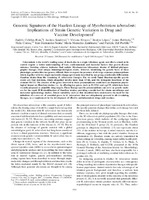Please use this identifier to cite or link to this item:
http://sgc.anlis.gob.ar/handle/123456789/287| Title: | Genomic signatures of the haarlem lineage of Mycobacterium tuberculosis: implications of strain genetic variation in drug and vaccine development | Authors: | Cubillos-Ruiz, Andrés Sandoval, Andrea Ritacco, Viviana López, Beatriz Robledo, Jaime Correa, Nidia Hernandez-Neuta, Iván Zambrano, Maria Mercedes Del Portillo, Patricia |
Keywords: | Mycobacterium tuberculosis;Tuberculosis;Mutagénesis Insercional;Antituberculosos;Polimorfismo Genético | Issue Date: | 2010 | Description: | Tuberculosis is the world’s leading cause of death due to a single infectious agent, and efforts aimed at its control require a better understanding of host, environmental, and bacterial factors that govern disease outcome. Growing evidence indicates that certain Mycobacterium tuberculosis strains of distinct phylogeographic lineages elicit unique immunopathological events. However, identifying the genetic basis of these phenotypic peculiarities has proven difficult. Here we report the presence of six large sequence polymorphisms which, together with two single-nucleotide changes previously described by our group, consistently differentiate Haarlem strains from the remaining M. tuberculosis lineages. The six newly found Haarlem-specific genetic events are four deletions, which altogether involve more than 13 kb, and two intragenic insertions of the element IS6110. The absence of the genes involved in these polymorphisms could have an important physiological impact on Haarlem strains, i.e., by affecting key genes, such as Rv1354c and cyp121, which have been recently proposed as plausible drug targets. These lineage-specific polymorphisms can serve as genetic markers for the rapid PCR identification of Haarlem strains, providing a useful tool for strain surveillance and molecular epidemiology studies. Strain variability such as that described here underscores the need for the definition of a core set of essential genes in M. tuberculosis that are ubiquitously present in all circulating lineages, as a requirement in the development of effective antituberculosis drugs and vaccines. Fil: Cubillos-Ruiz, Andrés. Corporación Corpogen; Colombia. Fil: Sandoval, Andrea. Corporación Corpogen; Colombia. Fil: Ritacco, Viviana. ANLIS Dr.C.G.Malbrán. Instituto Nacional de Enfermedades Infecciosas; Argentina. Fil: López, Beatriz. ANLIS Dr.C.G.Malbrán. Instituto Nacional de Enfermedades Infecciosas; Argentina. Fil: Robledo, Jaime. Universidad Pontificia Bolivariana. Corporación para Investigaciones Biológicas; Colombia. Fil: Correa, Nidia. Universidad Pontificia Bolivariana. Corporación para Investigaciones Biológicas; Colombia. Fil: Hernandez-Neuta, Iván. Corporación Corpogen; Colombia. Fil: Zambrano, Maria Mercedes. Corporación Corpogen; Colombia. Fil: Del Portillo, Patricia. Corporación Corpogen; Colombia. |
URI: | http://jcm.asm.org/content/48/10/3614.full.pdf+html http://sgc.anlis.gob.ar/handle/123456789/287 |
ISSN: | 1098-660X | Rights: | info:eu-repo/semantics/openAccess |
| Appears in Collections: | snrd Publicaciones INEI |
Files in This Item:
| File | Description | Size | Format | |
|---|---|---|---|---|
| JournalofClinicalMicrobiology,2010,48(10),3614–3623..pdf | 1.34 MB | Adobe PDF |  View/Open |
Page view(s)
188
checked on Jan 6, 2026
Download(s)
79
checked on Jan 6, 2026
Google ScholarTM
Check
Items in DSpace are protected by copyright, with all rights reserved, unless otherwise indicated.

